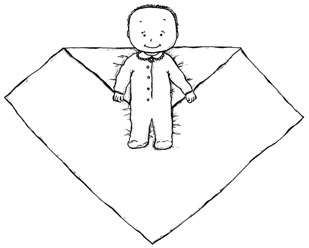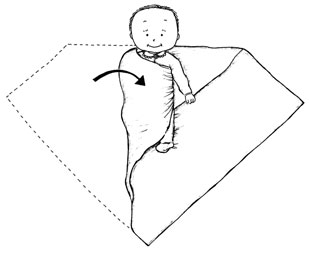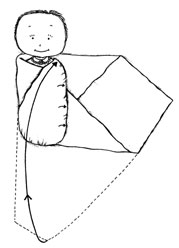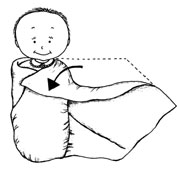The No Cry Nap Solution (30 page)
Read The No Cry Nap Solution Online
Authors: Elizabeth Pantley
your baby, and then lay your baby down on the nice, warm bed.
Keep your hand on your baby’s tummy for a minute or two and
then slowly move your hand away. This gradual transition can
help your baby accept his bed for naptime.
Wait Until Your Baby Is Sleeping and
Gently Turn Him Over
If your baby truly resists back sleeping yet you know that he is
overtired and needing a nap, you can stay with him while he falls
asleep on his tummy, and when he is asleep, gently turn him over.
This isn’t the best overall solution, since you don’t want to have to
be involved in your baby’s every nap or run the risk of leaving him
to sleep on his tummy. You also don’t want to encourage tummy
sleeping. However, when your baby is overtired, this can be a help-
ful temporary solution.
Monitor Your Baby’s Health
A baby who is suffering from refl ux, an ear infection, or other
health problem might be resisting sleep for this reason. If your
baby seems physically uncomfortable with back sleeping, talk it
over with your health care provider.
190 Solving Napping Problems
Talk to Your Doctor About a Compromise:
Side Sleeping
In most cases, side sleeping is a very distant second choice to back
sleeping, but if your baby absolutely will not sleep on his back, you
can discuss this option with your health care provider. Ask if a
specialty sleeping wedge or tightly rolled baby blanket can be used
to hold your baby in this position.
Provide Lots and Lots
and Lots
of Daytime
Tummy Playtime
Tummy sleeping becomes safe when your baby is able to have full
control of her head, arms, and body, moving freely from tummy
to side to back. To encourage this development, give your baby
plenty of fl oor time to develop her muscle control.
Create a safe place on the fl oor with a clean mat. Surround
your baby with toys. And get down there with him! Nothing will
motivate your baby more than a loving playmate.
Keep Your Baby’s Bed Safe
Finally, if you still choose to have your baby sleep on her tummy
despite everything you’ve read, heard, and been told—or if your
doctor has approved this position—make certain that your baby’s
mattress is even, fi rm, and fl at. Every time you put her to bed,
check to be sure that the sheets are clean, smooth, and tightly
secured. Don’t put any pillows, blankets, or toys in bed with her.
Remove bumper pads, and be sure your mattress fi ts properly in
the crib. If you have concerns, ask your doctor or hospital about
renting a sophisticated device that monitors baby’s sound, move-
ment, and breathing. (These should never be used without a doc-
tor’s supervision.)
Helping Your Newborn Tummy Sleeper Go “Back to Sleep”
191
Now That Your Baby Is Sleeping on
Her Back
Congratulations! Your baby is now an offi cial back sleeper. As
soon as your baby gains control of her body movements and is
able to hold her head up and master rolling back and forth on her
own, she’ll be free to sleep in whatever position she fi nds most
comfortable. In the meantime, look over the pointers on page 171
to protect your baby’s head from developing a fl at spot, a potential
but avoidable side effect caused by back sleeping.
Back Sleeping at Day Care or
with Babysitters
If your baby naps while under the care of a babysitter, relative, or
day care provider, you’ll want to discuss back sleeping with these
adults. Not all child care centers have policies on infant sleep
positions; or even when they do, not all child care providers abide
by the guidelines. Babies who are not used to sleeping on their
stomachs are at a particularly high risk for SIDS when placed in
this position at day care. Check on the policies in your center, and
be sure that they are placing your baby in the proper sleep position
as recommended by specialists and your doctor.
This Phase Passes Quickly
Even if your newborn never adjusts happily to back sleeping, you
can take heart in knowing that this is a temporary issue. In a few
weeks when your baby is able to better control his body, he’ll be
safe sleeping in whatever position he desires.


How to Use Swaddling
for Naptime
See also: The Nap Resister: When Your Child Needs
a Nap but Won’t Take One; Swinging, Bouncing,
Vibrating, or Gliding: Making the Transition
from Motion Sleep to Stationary Sleep
My newborn was swaddled at the hospital. Now
that we’re home, should we continue to swaddle
her? When should we wean her from it and how?
Swaddling your baby is a fantastic way to calm her and help her
to nap better and longer because it creates a womblike feeling:
she’s snugly tucked in and warmly embraced on all sides. In addi-
tion, since your baby’s arms and legs are tucked tightly, this can
prevent the startle refl ex from waking her up from her nap before
she’s ready to be awake. Swaddling can be especially helpful as a
nap aid if your baby is colicky or fussy.
How to Swaddle Your Baby
If you’re new to swaddling, it can be a bit confusing. However,
when you’ve done it a few times, it will become effortless. Your
baby might also require a little bit of time to adjust to swaddling,
so allow him a few practice times before you decide if this is a good
choice for your infant’s naptime.
You’ll need a blanket that’s not too much bigger than your
newborn—a square receiving blanket is the perfect size. Its fabric
192
How to Use Swaddling for Naptime
193
should be lightweight and breathable. Try swaddling a few times
when your baby is happy so that you’re not struggling with a fussy
or rigid baby—or try swaddling a doll, stuffed animal, or a friend’s
experienced baby fi rst. Everybody’s method is a little different, but
here are the basic directions (see illustrations on the next page):
1. On a stable surface (such as a bed or clean fl oor), lay the
blanket out in front of you so it’s shaped like a diamond.
Fold down the top corner. Place baby in the middle of the
blanket with his head lying on top of the folded corner.
2. Hold your baby’s right arm down against his body. Pull the
left corner of the blanket across baby and over his right
arm so that it’s snug but not too tight. Tuck this corner
under his body on the other side.
3. Bring your baby’s left arm to his side, and bring the blan-
ket’s bottom corner up and tuck it under his left shoulder.
4. Pull the upper edge of the blanket down over his left shoul-
der, and bring the right corner across baby, keeping both
his arms down against his body.
5. Pull the tail of the blanket around your baby like a belt,
and tuck it in where it fi ts to prevent the blanket from
unwrapping, or simply hold your baby or position him so it
remains snug.
A veteran parent, a nurse, your doula, your lactation consul-
tant, or your doctor can give you a swaddling demonstration if you
can’t seem to get it right. It can seem like a complicated process,
but once you’ve seen it done a few times, you’ll get the hang of it.
And both you and your baby should enjoy the calming results.
Tips for Safe and Happy Swaddling
• When swaddling your baby, you’ll want her toasty warm,
not hot. To check your baby’s temperature, slide your hand
inside the swaddle to her chest and belly. She should feel
comfortably warm, not hot or sweaty. Modify the thickness




